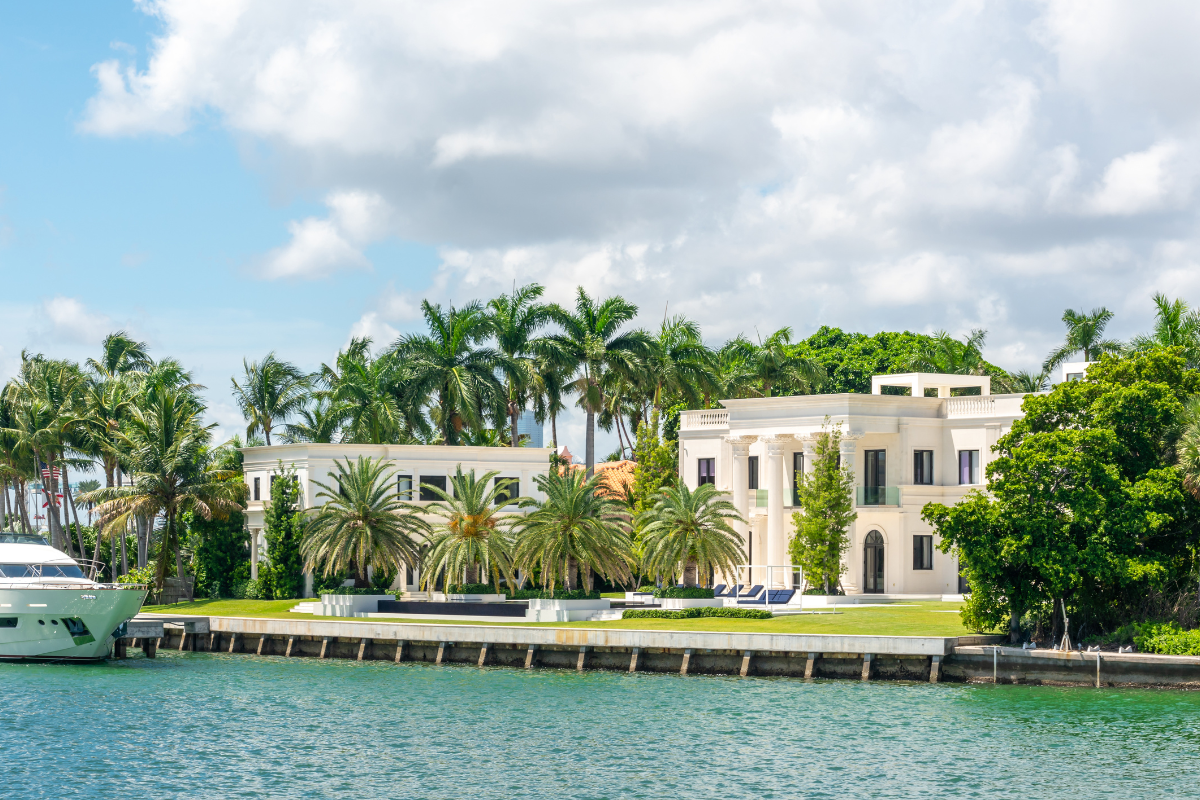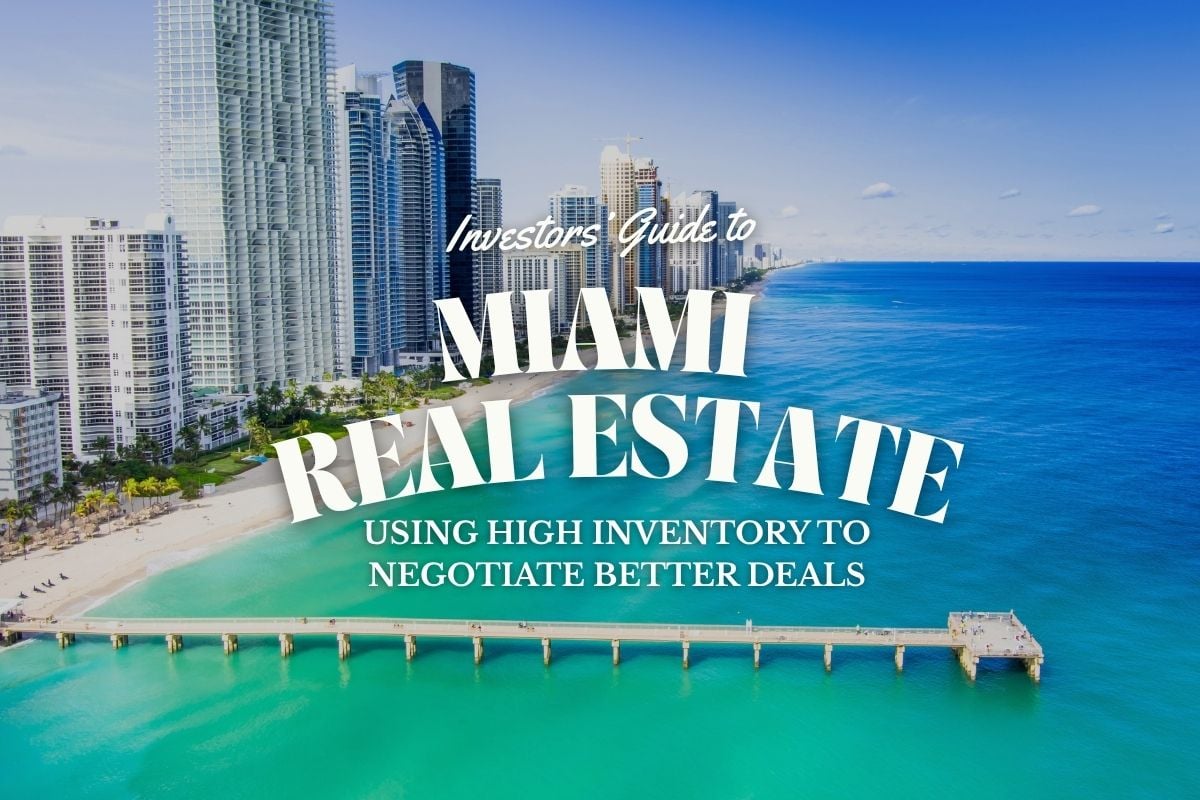Miami real estate has always attracted attention from investors around the world. Known for its luxury waterfront homes, high-rise condos, and international buyer appeal, Miami is a market that rarely sits still. But the dynamics in 2025 look very different from the boom years of the pandemic era. A surge in inventory, longer days on market, and a slowdown in bidding wars have shifted negotiating power away from sellers and into the hands of buyers.
For the first time in years, investors have room to breathe. Instead of rushing into bidding wars, you can compare multiple properties, perform thorough due diligence, and extract meaningful concessions from motivated sellers. In other words, Miami’s current oversupply of condos and high-end homes is giving investors leverage they haven’t seen in nearly a decade.
This guide explores why Miami’s high inventory is such a valuable tool for investors. You will learn how the surge in supply is creating opportunities across neighborhoods like Brickell condos investment opportunities, Miami Beach luxury homes for sale, and Coconut Grove waterfront properties. We’ll dive into which property types are the most negotiable right now, the exact strategies you can use to secure discounts and favorable terms, and the risks you must watch out for.
Whether you are interested in luxury waterfront estates, urban condos, or emerging investment hubs like Wynwood and Doral, this is the moment to approach Miami real estate with a strategic, investor-focused mindset.

Miami Market Overview: Inventory and Buyer Leverage
Miami’s housing market has gone from one of the nation’s hottest to one of its most balanced. For investors, that means opportunity.
- Active Listings: As of April 2025, Miami-Dade County had 19,319 active listings, the highest number since 2019. By comparison, during the peak of the pandemic boom, inventory dipped below 6,000.
- Months of Supply: With 9.7 months of supply available, the region is firmly in buyer’s market territory. Historically, anything above 6 months signals leverage for buyers.
- Condo Market Pressure: Condos are leading the surge, with inventory jumping more than 40 percent year-over-year. High-rise districts like Brickell, Downtown Miami, and Sunny Isles are especially oversupplied, giving investors room to negotiate.
- Single-Family Homes: Inventory of single-family homes rose 44 percent year-over-year. While entry-level homes under $400,000 remain tight, luxury homes in Coral Gables and Miami Beach are sitting longer and seeing price reductions.

Neighborhood Impact
- Brickell and Downtown Miami: Oversupply of new and resale condos is driving longer days on market, making this a sweet spot for condo investors.
- Miami Beach: Even waterfront homes that once sparked bidding wars are now sitting unsold for months, especially those priced above $5 million.
- Coral Gables and Coconut Grove: Family-friendly luxury areas with prestige appeal, but with rising inventory, investors can secure stronger concessions.
- Wynwood and Midtown: Developers are offering incentives such as design credits, free upgrades, or mortgage rate buydowns to attract buyers.
For investors, this oversupply means choice and leverage. Sellers who might have ignored low offers two years ago are now calling buyers back to the table.
Why High Inventory Matters to Investors
High inventory doesn’t just mean more listings. It reshapes the way deals get made. For investors, this translates into several concrete advantages:
1. Discounted Pricing
With more homes on the market than active buyers, sellers are cutting prices to stay competitive.
- Luxury homes in Miami Beach are selling at 5–10 percent below original list price.
- Condos in oversupplied towers in Brickell are being marked down after sitting unsold for 120+ days.
2. Seller Concessions
Even when sellers resist large price cuts, they’re often willing to sweeten the deal in other ways. This can include:
- Covering closing costs (title, escrow, or transfer fees)
- Offering repair or renovation credits
- Extending inspection or financing contingency periods
- Considering seller financing or leasebacks
3. Reduced Buyer Competition
Investors no longer need to worry about bidding wars driving prices 20 percent above ask. Properties that once sold in days are now taking weeks or months, giving buyers time to evaluate.
4. Greater Deal Flow
Investors now have more options. Whether you want a cash-flowing rental, a condo flip, or a long-term luxury play, Miami’s inventory surge is creating opportunities across multiple neighborhoods and price ranges.
5. Timing the Market
Buying during a period of high inventory allows investors to lock in favorable terms before the market cycles back. If demand rebounds, those who bought discounted assets in Coral Gables or Coconut Grove will be positioned for outsized appreciation.

Negotiation Strategies Using Inventory Pressure
Having inventory on your side is only powerful if you know how to use it. Here are proven strategies Miami investors can apply in 2025:
1. Anchor Low, But With Data
Always support your offer with comps. If a condo in Brickell has been listed for 6 months at $750,000, point to recent comparable sales at $700,000. Present data on months of supply to justify your lower price.
2. Ask for Credits, Not Just Price Cuts
Sellers often resist lowering list prices because of pride or optics. Instead, request repair credits, appliance upgrades, or HOA fee contributions. For example, asking for $25,000 in repair credits on a Miami Beach condo may succeed where a $25,000 price cut fails.
3. Extend Due Diligence and Inspection Windows
In a high-inventory market, sellers are more willing to give buyers 21–30 days for inspections and financing. This is particularly important for older buildings where structural inspections are critical.
4. Offer Closing Flexibility
Luxury sellers in Coral Gables or Coconut Grove may need time to transition. Offering flexible move-out timelines or temporary leasebacks can secure you a better deal.
5. Bundle Purchases for Volume Discounts
Investors targeting multiple units in Wynwood, Midtown, or Edgewater can negotiate better by packaging offers. Sellers often discount when they can unload several properties in one deal.
6. Highlight Carrying Costs
Point out the high monthly expenses sellers face, especially in condo towers with steep HOA fees. Many prefer to accept a lower offer rather than continue paying $2,000+ a month in maintenance fees and taxes.

Risks, Pitfalls and What to Watch
Even with inventory on your side, investors must remain cautious.
- Deferred Maintenance: Older Miami Beach and Downtown condos may face assessments for roof, plumbing, or structural repairs. Always review HOA budgets and reserves.
- High Carrying Costs: Property taxes, insurance, and HOA fees are rising. Sunny Isles condos, for example, can carry HOA fees exceeding $1,500 per month.
- Appraisal Gaps: Lenders may not appraise properties as high as you’re offering. Be prepared with extra cash or stronger negotiation.
- Market Timing Risk: If inventory levels remain high longer than expected, appreciation may stall. Always run scenarios assuming flat or declining values.
- Liquidity Risks: Luxury properties in Coral Gables or Coconut Grove may take longer to resell, limiting your exit options. Consider short-term rental or leasing strategies as a backup.
Putting It Into Action: A Step by Step Investor Playbook
Here’s a practical framework for moving forward in today’s Miami market:
- Scout Listings: Focus on aged listings in Brickell, Edgewater, and Miami Beach where sellers are most negotiable.
- Run Comps: Pull recent sales and track listings that have been relisted or cut in price. Use this data to support your offers.
- Draft Offers with Context: Frame your bid with a short market memo highlighting inventory levels, comparable sales, and carrying costs.
- Negotiate Beyond Price: Ask for repair credits, extended inspections, and flexible closing terms.
- Perform Due Diligence: Hire inspectors and review HOA financials carefully, especially in older condo buildings.
- Close Strategically: Ensure all credits and concessions are properly documented. Protect your downside with contingencies.
- Execute Your Plan: Renovate, rent, or reposition the property. Track performance and adjust based on Miami’s evolving market.
- Plan Your Exit: Whether you intend to flip, hold, or refinance, plan ahead to maximize your gains.
Miami’s real estate market is evolving, and the surge in inventory has shifted power back into the hands of investors.
If you are considering your next move, now is a strong time to explore opportunities. For tailored guidance, reach out and let’s discuss how to position your investments in Miami’s shifting market.
FAQs
Q: Which Miami neighborhoods offer the strongest leverage?
A: Brickell condos, Miami Beach waterfront homes, and luxury homes in Coconut Grove and Coral Gables are the most negotiable right now.
Q: What about Airbnb or short-term rental investments?
A: Short-term rentals remain strong in areas like Miami Beach and Wynwood, but regulations vary by neighborhood. Always check zoning and condo bylaws before purchasing.
Q: Are new developments worth buying in this market?
A: Yes, especially in Wynwood and Midtown, where developers are offering mortgage buydowns, design credits, and free upgrades to attract buyers.
Q: How do I handle financing challenges?
A: Rising interest rates make financing more difficult. Explore adjustable-rate mortgages, portfolio loans, or builder incentives. Cash buyers still hold a strong advantage.
Q: Should I focus on condos or single-family homes?
A: Condos in oversupplied neighborhoods like Brickell offer the most immediate discounts, while single-family homes in Coral Gables or Coconut Grove hold better long-term appreciation potential.
Q: How much of a discount should I realistically expect?
A: For condos, 5–12 percent below asking is common today. For luxury homes over $5 million, double-digit discounts plus concessions are possible.

